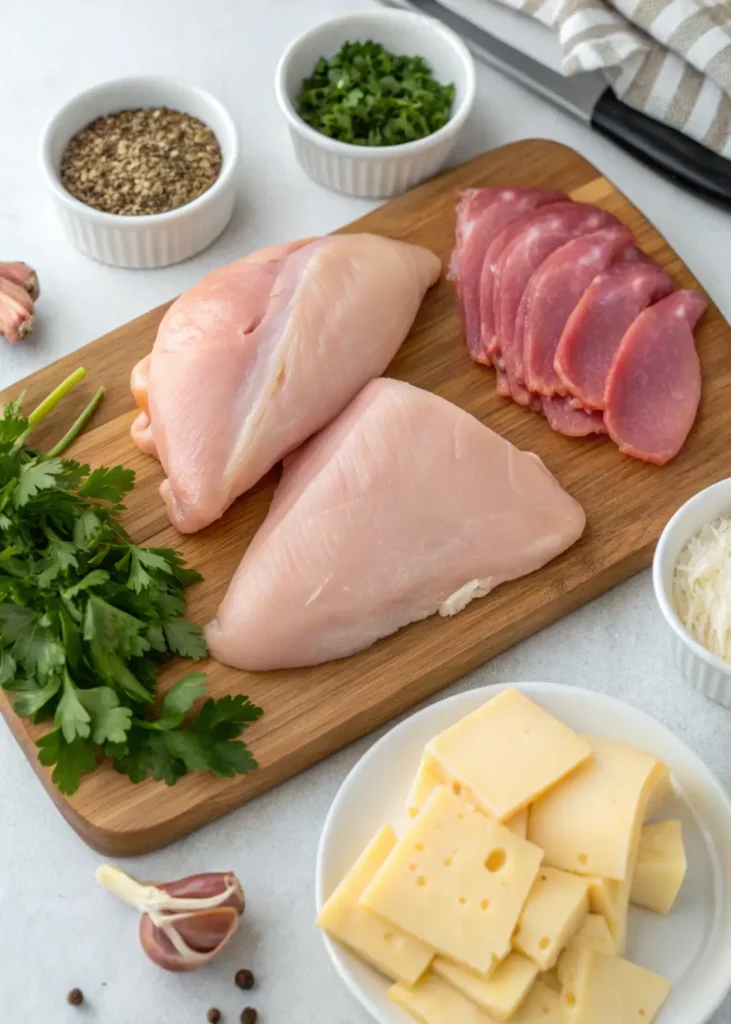Table of Contents
Did you know that 68% of home-cooked chicken cordon bleu gets thrown away because people don’t know how to properly store and reheat it? This classic chicken cordon bleu dish tender chicken wrapped around ham and Swiss cheese deserves better than the trash bin! Whether you’ve made too much baked chicken cordon bleu for dinner or want to meal prep this elegant dish ahead of time, knowing the proper freezing and reheating techniques will save you time, money, and deliver restaurant-quality results every time. This guide walks you through five foolproof steps to freeze and reheat your chicken cordon bleu while maintaining its crispy exterior and gooey cheese center.
Ingredients List

For the chicken cordon bleu (if making from scratch):
- 4 boneless, skinless chicken breasts (about 6-8 oz each)
- 4 slices of high-quality ham (Black Forest or honey ham work beautifully)
- 4 slices of Swiss cheese (can substitute Gruyère for a nuttier flavor)
- 1 cup all-purpose flour
- 1 teaspoon salt
- ½ teaspoon black pepper
- 2 large eggs, beaten
- 2 tablespoons milk
- 1½ cups panko breadcrumbs (regular breadcrumbs work too, but won’t be as crispy)
- 2 tablespoons fresh parsley, finely chopped
- 2 tablespoons unsalted butter, melted
- 2 tablespoons olive oil
For freezing:
- Plastic wrap
- Aluminum foil
- Freezer-safe container or zip-top bags
- Optional: vacuum sealer
Timing
Preparation for freezing: 15 minutes (not including initial cooking time) Freezing time: 1-2 hours for flash freezing Storage duration: Up to 3 months in the freezer Reheating time: 25-40 minutes (30% less time than cooking from scratch!) Total active time: Under 30 minutes
Step-by-Step Instructions
Step 1: Cool Your Chicken Cordon Bleu Properly
Before freezing your chicken cordon bleu, you must cool it properly to prevent bacterial growth and maintain food safety. Never place hot food directly in the freezer!
- Allow your freshly cooked chicken cordon bleu to cool at room temperature for no more than 30 minutes.
- For faster cooling, place the chicken on a wire rack to allow air circulation around the entire piece.
- Once it’s no longer steaming, transfer to the refrigerator and chill completely (about 1-2 hours).
Pro tip: If you’re meal prepping, you can actually freeze chicken cordon bleu before cooking it! Prepare the rolled, breaded chicken but don’t cook it freeze at this stage for best results when reheating.
Step 2: Wrap Individual Portions
The key to successfully freezing chicken cordon bleu is proper wrapping to prevent freezer burn and maintain quality.
- Cut your chicken cordon bleu into individual portions if not already done.
- Wrap each piece tightly in plastic wrap, ensuring there are no exposed areas.
- Follow with a layer of aluminum foil for extra protection against freezer burn.
- Press out as much air as possible during wrapping.
Pro tip: If you have a vacuum sealer, use it here! Vacuum-sealed chicken cordon bleu can last up to 6 months in the freezer with minimal quality loss.
Step 3: Flash Freeze for Best Results
Flash freezing prevents your chicken pieces from sticking together and helps maintain their shape.
- Place the individually wrapped portions on a baking sheet, ensuring they’re not touching.
- Put the baking sheet in the freezer for 1-2 hours until the chicken pieces are solid.
- Once frozen, transfer the wrapped portions to a larger freezer-safe container or zip-top bag.
- Label with the date and contents (you’ll thank yourself later!).
Pro tip: Place a piece of parchment paper between layers if stacking multiple pieces in one container.
Step 4: Thaw Safely Before Reheating
Proper thawing is crucial for food safety and texture quality when reheating chicken cordon bleu.
- Transfer your frozen chicken cordon bleu from the freezer to the refrigerator 24 hours before you plan to eat it.
- Keep it wrapped during thawing to prevent moisture loss.
- If you’re in a hurry, you can use the defrost setting on your microwave, but be careful not to start cooking the edges.
Pro tip: Never thaw chicken at room temperature as this puts it in the “danger zone” for bacterial growth (40°F-140°F/4°C-60°C).
Step 5: Reheat to Perfection
The final step is reheating your chicken cordon bleu while maintaining its crispy exterior and preventing the cheese from leaking out.
Oven method (recommended):
- Preheat your oven to 350°F (175°C).
- Unwrap the thawed chicken and place it on a baking sheet lined with parchment paper.
- Lightly brush with olive oil to help re-crisp the coating.
- Bake for 20-25 minutes until the internal temperature reaches 165°F (74°C).
Air fryer method:
- Preheat air fryer to 350°F (175°C).
- Lightly spray the basket with cooking oil.
- Cook for 12-15 minutes, flipping halfway through.
Microwave method (quick but not ideal for texture):
- Place on a microwave-safe plate.
- Cover with a damp paper towel.
- Heat on medium power for 2-3 minutes, then check and continue in 30-second increments if needed.
Pro tip: For the ultimate crispy exterior, finish oven-reheated chicken under the broiler for 1-2 minutes watch carefully to prevent burning!
Nutritional Information
Per serving of chicken cordon bleu (values may vary based on specific ingredients and portions):
- Calories: 420
- Protein: 40g
- Carbohydrates: 20g
- Fat: 22g (7g saturated)
- Sodium: 680mg
- Fiber: 1g
Did you know? Freezing chicken cordon bleu doesn’t significantly impact its nutritional value, though some minimal vitamin loss may occur during extended storage.
Healthier Alternatives for the Recipe
Want to enjoy chicken cordon bleu with fewer calories or adapted to different dietary needs? Try these modifications:
- Lower carb option: Replace breadcrumbs with crushed pork rinds or almond flour for a keto-friendly version.
- Gluten-free alternative: Use gluten-free breadcrumbs and ensure your ham doesn’t contain gluten additives.
- Lighter version: Bake instead of fry your chicken cordon bleu, and use reduced-fat cheese to cut approximately 100 calories per serving.
- Higher protein option: Add a layer of spinach inside your chicken roll-ups for extra nutrients with minimal calories.
Serving Suggestions
Your perfectly reheated chicken cordon bleu deserves complementary sides:
- Serve with roasted asparagus and a small portion of wild rice for a balanced plate.
- A light arugula salad with lemon vinaigrette offers a refreshing contrast to the rich chicken.
- For a make-ahead meal, pair with blanched green beans that can be quickly sautéed while the chicken reheats.
- Drizzle with a small amount of dijon cream sauce (made with Greek yogurt instead of heavy cream) for extra flavor without excessive calories.
Common Mistakes to Avoid
Don’t let these pitfalls ruin your chicken cordon bleu:
- Impatient thawing: 62% of food poisoning cases involving chicken come from improper thawing. Always thaw in the refrigerator, never on the counter.
- Overheating when reheating: This causes cheese to leak out and chicken to dry out. Use a food thermometer to know when it’s ready (165°F/74°C).
- Using high microwave power: This creates hot spots and rubbery texture. Always use medium power if using a microwave.
- Not protecting from freezer burn: Double wrapping is essential for maintaining quality beyond a week in the freezer.
- Freezing already-reheated portions: Each reheat cycle degrades quality and safety. Only reheat what you’ll eat.
Storing Tips for the Recipe
Beyond basic freezing, optimize your chicken cordon bleu storage with these tips:
- Store uncooked, prepared chicken cordon bleu in the freezer for up to 3 months for best quality.
- Cooked chicken cordon bleu lasts 3-4 days in the refrigerator perfect for planned leftovers.
- If you make a large batch, portion it before freezing for easy single servings.
- Store any accompanying sauce separately from the chicken for best results when reheating.
- For a quick weeknight dinner solution, freeze individual portions with a side of vegetables in meal prep containers.
Conclusion
Mastering the art of freezing and reheating chicken cordon bleu means you can enjoy this elegant dish any day of the week without compromise. By following these five simple steps cooling properly, wrapping individually, flash freezing, thawing safely, and reheating to perfection you’ll preserve both the flavor and texture that makes chicken cordon bleu so special. With proper techniques, your make-ahead chicken cordon bleu can taste just as delicious as freshly made, saving you valuable time in the kitchen without sacrificing quality.
Ready to put these tips into practice? Next time you make chicken cordon bleu, prepare a double batch and freeze the extra portions using this method. Then share your results in the comments below!
FAQs
Can I freeze chicken cordon bleu after it’s been cooked? Yes, you can freeze cooked chicken cordon bleu, but for best results, freeze it before cooking after you’ve assembled and breaded it.
How long can I keep chicken cordon bleu in the freezer? Properly wrapped chicken cordon bleu will maintain best quality for up to 3 months in the freezer, though it remains safe indefinitely at 0°F (-18°C).
Can I reheat chicken cordon bleu from frozen without thawing? While possible, it’s not recommended. Thawing first ensures even reheating and better texture. If you must reheat from frozen, add 50% more cooking time and use an oven method.
Will the breading still be crispy after freezing and reheating? The breading won’t be quite as crispy as fresh, but using the oven or air fryer methods and brushing with a little oil before reheating helps restore much of the crispness.
Can I prepare chicken cordon bleu in advance for a party? Absolutely! Prepare and freeze uncooked, breaded chicken cordon bleu up to a month ahead. Thaw in the refrigerator the day before, then bake fresh for your event.
Is it safe to refreeze chicken cordon bleu that has been thawed? Only if it was thawed in the refrigerator and hasn’t been at room temperature for more than 2 hours. However, quality will suffer with each freeze-thaw cycle.

